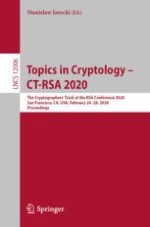2020 | Buch
Topics in Cryptology – CT-RSA 2020
The Cryptographers’ Track at the RSA Conference 2020, San Francisco, CA, USA, February 24–28, 2020, Proceedings
herausgegeben von: Stanislaw Jarecki
Verlag: Springer International Publishing
Buchreihe : Lecture Notes in Computer Science
